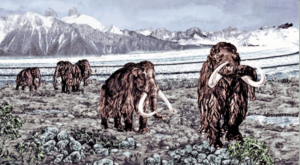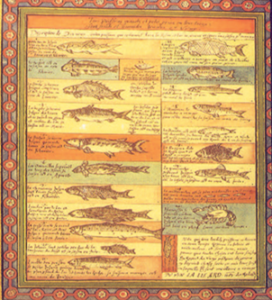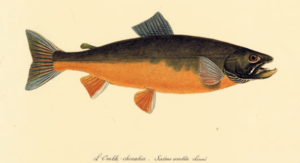
The manuscript presents an in-depth exploration of the Arctic char, a native species in Lake Geneva, tracing its lineage back to the post-glacial era approximately 13,000 years ago. This study delves into the historical documentation of the species, starting from a notable manuscript in 1150, and continuing through various historical records, including acts and laws. The systematic classification of the Arctic char in Lake Geneva has been a topic of considerable scientific discourse, marked by differing species descriptions over time. Current consensus recognizes Salvelinus alpinus as the sole species inhabiting the lake. The research also examines the socio-economic aspects of Arctic char fishing in the region, highlighting its dual role as both an economic resource and a recreational pursuit. Notably, the manuscript addresses the significant surge in fishing yields during the 1990s, followed by a persistent decline in recent years. This study not only provides a historical perspective on the Arctic char but also underscores the dynamic interplay between environmental changes and fishing activities in Lake Geneva.
Copyright © 2023 Daniel Patrik. This is an open access article distributed under the Creative Commons Attribution License, which permits unrestricted use, distribution, and reproduction in any medium, provided the original work is properly cited.

Figure 1: The future Lake Geneva region during the last ice age. © Cantonal Museum of Geology, Lausanne. Reproduced with the permission of the Cantonal Geology Museum of Lausanne.
The initial documentation of Arctic char in Lake Geneva is found in a 1150 text, where the canons of Ste-Marie d’Aoste granted the priory of St- Jean de Genève, for the annual payment in wine, wheat, and substantial fish (trout, char, pike), essential for their refectory. In 1288, char makes another appearance in the accounts of the Châtelain of Chillon, noting that 140 char, 7 char, and 11 large trout, received from the Châtelain of the Island of Geneva, were dispatched to the Count of Savoy at Le Bourget.
An act by Amédée, Count of Savoy, dated April 23, 1376, establishing the fish prices at the Villeneuve market, already indicates that trout and char were the most expensive fish in the lake. They were valued at 6 Lausanne deniers per pound during Lent, 3 deniers from Easter to All Saints’ Day, and 5 deniers from All Saints’ Day to Lent. In comparison, pikes were worth 4, 2, and 3 deniers during the corresponding periods. Notably, in 1396, the Châtelain relinquished his right to fish for char around the castle for 40 sous, as recorded in the Chillon accounts. This right was later revoked from the fishermen of Villeneuve by a decree from their Excellencies of Berne on July 16, 1541, which prohibited fishing and trading around the castle.
Char is also documented on the 1581 map of Syndic of Geneva, Jean du Villard, who describes “19 types of fish found in Rosen and Lake Geneva and their true season for eating” (Fig. 2). The description of char reads: “Good fish- It resides in the lake at depths of up to 15 pounds, favouring rocky areas, and its feeding season occurs in January.

Figure 2: Jean Duvillard (Geneva 1539-1610). Description of nineteen kinds of fish, 1581 Pen and ink, watercolor, heightened with white gouache on paper in two sheets: 32.8
Among the benefits of the bailiwick of Nyon, as listed in 1613, it is stated that all fishermen must present their fish to the castle and sell them at prices fixed in advance. Large trout and Arctic char are the most expensive fish. They are valued at 6 cents per pound from Easter to St. Michael’s Day, 7 cents from St. Michael’s Day to Mardi Gras, and 8 cents during Lent. In comparison, perchettes are only paid a penny per pound throughout the year [4]. finally mentions that on December 13, 1621, Jacques and Jean Pappan of Morges sold to Pierre Paccard of Geneva all the fish they could catch until next Easter, including “ambles” (char) at 4 sols per pound before Lent and 5 sols during Lent.
Lunel (1874), in his “Natural History of Fish in the Lake Geneva Basin,” mentions that “the fishermen and fish merchants of Lake Geneva assure that the yellow-orange color of the char is due to the influence of a tuff quarry which is located in the vicinity of the places where these fish spawn, because, according to them, the Chars taken outside this locality show no trace of this coloring” (Fig. 3). However, he refutes this argument by mentioning that these are simply mature char, displaying their spawning livery, which is captured at this time, in this place.
Nevertheless, it is interesting to note that the fishermen had noticed that the char only came during the reproduction period to a place rich in rock. Without knowing it, they perfectly described the migration of char in winter on the umbrellas! On the other hand, Lunel (1874) indicates a very surprising period for reproduction: “In the last fortnight of January, the Arctic char, which until then had remained in depths of up to two hundred meters and more, go up more or less and come to settle on the spawning grounds; this begins in February and sometimes extends well before March”(Fig. 3). This apparent error in determining the reproduction period will have serious consequences for the char population since the spawners will no longer be protected and fishermen, legally, will catch them en masse between November and January for several years.

Figure 3
The earliest mention dates back to 1150 in a manuscript where the canons of Ste-Marie d’Aoste granted the priory of St-Jean de Genève the annual supply of wine, wheat, and large fish, including char (trout, char, pike). By 1288, the Châtelain of Chillon’s accounts noted the transfer of char and trout to the Count of Savoy, emphasizing their importance.
In 1376, an act by Amédée, Count of Savoy, established the market prices for fish, with trout and char being the most expensive varieties.
By 1581, a map by Syndic of Geneva, Jean du Villard, highlighted char as a prized fish, providing insights into its behavior and seasonal availability.
In the early 17th century, records from the bailiwick of Nyon outlined the pricing structure for char, emphasizing their economic significance.
Despite various historical mentions, the char population faced challenges, including legal restrictions and changes in fishing practices.
Crettiez (1906) introduced the concept of three char varieties based on habitat variability: yellow char spawning in Yvoire, gray char in Meillerie, and white char in Locum. Subsequent research, led by André (1922)[7], generally referred to a single species either Salvelinus umbla or Salvelinus alpinus.
These historical perspectives provide insights into the evolution of char species in Lake Geneva, from their arrival after the last glaciation to the complexities of their reproduction and variability in habitat.